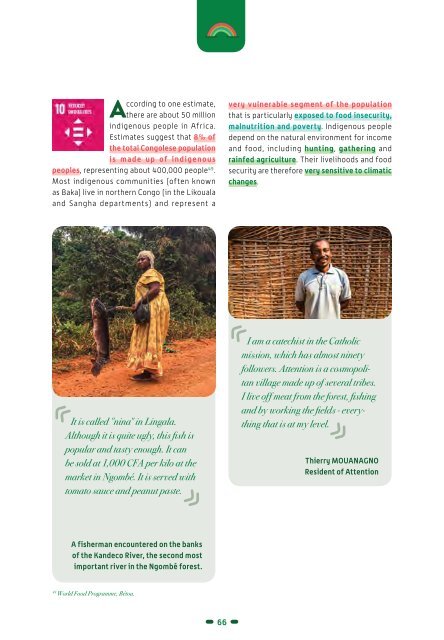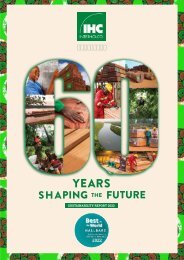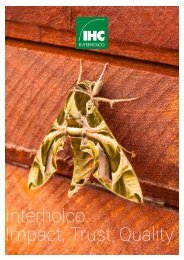An ALLIANCE culture to safeguard Africa's forests
INTERHOLCO invites you to discover "SUSTAINABLE HARDWOOD, MADE IN AFRICA" and the solutions it offers for meeting the major challenges facing the planet. A forest is so much more than just its trees. She is the nurturing mother and source of healing for the local communities and indigenous peoples who have interacted with her over the course of thousands of years. She is the land where their identities, relationships, traditions and cultures come to life; the sacred being animated by their hopes for the future. She is home to thousands of species, from fungi to insects, from birds to gorillas. She regulates the water cycle and the formation of the rainfall that is so critical to the balance of the climate and the survival of the Earth. She offers the world's population a revolutionary material: wood. Known and used since antiquity, it is the only building material that is healthy, natural, sustainable, traceable, recyclable, renewable and carbon positive. See you on our web site: www.interholco.com
INTERHOLCO invites you to discover "SUSTAINABLE HARDWOOD, MADE IN AFRICA" and the solutions it offers for meeting the major challenges facing the planet.
A forest is so much more than just its trees. She is the nurturing mother and source of healing for the local communities and indigenous peoples who have interacted with her over the course of thousands of years. She is the land where their identities, relationships, traditions and cultures come to life; the sacred being animated by their hopes for the future. She is home to thousands of species, from fungi to insects, from birds to gorillas. She regulates the water cycle and the formation of the rainfall that is so critical to the balance of the climate and the survival of the Earth. She offers the world's population a revolutionary material: wood. Known and used since antiquity, it is the only building material that is healthy, natural, sustainable, traceable, recyclable, renewable and carbon positive.
See you on our web site: www.interholco.com
You also want an ePaper? Increase the reach of your titles
YUMPU automatically turns print PDFs into web optimized ePapers that Google loves.
According <strong>to</strong> one estimate,<br />
there are about 50 million<br />
indigenous people in Africa.<br />
Estimates suggest that 8% of<br />
the <strong>to</strong>tal Congolese population<br />
is made up of indigenous<br />
peoples, representing about 400,000 people 49 .<br />
Most indigenous communities (often known<br />
as Baka) live in northern Congo (in the Likouala<br />
and Sangha departments) and represent a<br />
very vulnerable segment of the population<br />
that is particularly exposed <strong>to</strong> food insecurity,<br />
malnutrition and poverty. Indigenous people<br />
depend on the natural environment for income<br />
and food, including hunting, gathering and<br />
rainfed agri<strong>culture</strong>. Their livelihoods and food<br />
security are therefore very sensitive <strong>to</strong> climatic<br />
changes.<br />
According <strong>to</strong> a survey of Baka residing in<br />
Cameroon, when there is a dispute between an<br />
indigenous person and a Bantu, the law that is<br />
applied is in keeping with Bantu cus<strong>to</strong>m, and<br />
this is not without its difficulties. 50 In 2011, RoC<br />
became the first country in Africa <strong>to</strong> adopt a<br />
law that specifically promotes and protects<br />
the rights of indigenous peoples. However, the<br />
relationship between local communities (often<br />
referred <strong>to</strong> as 'Bantu') and indigenous peoples<br />
is based on unequal economic alliances centred<br />
on specific activities such as farming or hunting.<br />
These relationships often favour the economic<br />
interests of local communities over those of<br />
indigenous peoples 51 . Indigenous women have<br />
even fewer economic opportunities and are<br />
therefore even more vulnerable than indigenous<br />
men.<br />
With a resident population of 16,000, including indigenous<br />
peoples living in the Ngombé forest, IN-<br />
TERHOLCO supports and uses FPIC (free, prior and<br />
informed consent 52 ) as defined by the UN Permanent<br />
Forum on Indigenous Issues 53 , as adopted by<br />
the ILO 54 and as implemented by the FSC ©55 . FPIC<br />
was developed by the international community<br />
with the aim of protecting the cultural integrity,<br />
livelihoods and rights, (including cus<strong>to</strong>mary and<br />
traditional rights) of indigenous peoples and local<br />
communities and, above all, the right of indigenous<br />
peoples <strong>to</strong> self-determination.<br />
It is called "nina" in Lingala.<br />
Although it is quite ugly, this fish is<br />
popular and tasty enough. It can<br />
be sold at 1,000 CFA per kilo at the<br />
market in Ngombé. It is served with<br />
<strong>to</strong>ma<strong>to</strong> sauce and peanut paste.<br />
I am a catechist in the Catholic<br />
mission, which has almost ninety<br />
followers. Attention is a cosmopolitan<br />
village made up of several tribes.<br />
I live off meat from the forest, fishing<br />
and by working the fields - everything<br />
that is at my level.<br />
Thierry MOUANAGNO<br />
Resident of Attention<br />
A fisherman encountered on the banks<br />
of the Kandeco River, the second most<br />
important river in the Ngombé forest.<br />
49<br />
World Food Programme, Bé<strong>to</strong>u.<br />
50<br />
https://www.voaafrique.com/a/la-détresse-des-peuples-au<strong>to</strong>ch<strong>to</strong>nes-du-cameroun/5034265.html<br />
51<br />
https://www.un.org/esa/socdev/unpfii/documents/2013/Media/Fact%20Sheet_Africa_%20UNPFII-FR-12.pdf<br />
52<br />
Free Prior Informed Consent (FPIC) ; https://en.wikipedia.org/wiki/Free,_prior_and_informed_consent<br />
53<br />
United Nations Permanent Forum on Indigenous Issues, UNPFII ; https://www.un.org/development/desa/indigenouspeoples/<br />
54<br />
C169 - Indigenous and Tribal Peoples Convention, 1989 (No. 169); https://www.ilo.org/dyn/normlex/en/f?p=NORMLEX-<br />
PUB:12100:0::NO::P12100_ILO_CODE:C169<br />
55<br />
FSC guidelines for the implementation of the right <strong>to</strong> free, prior and informed consent (FPIC) ; https://fsc.org/en/document-center/<br />
documents/23275b28-3697-420e-9316-4092eeab1498<br />
66 67














